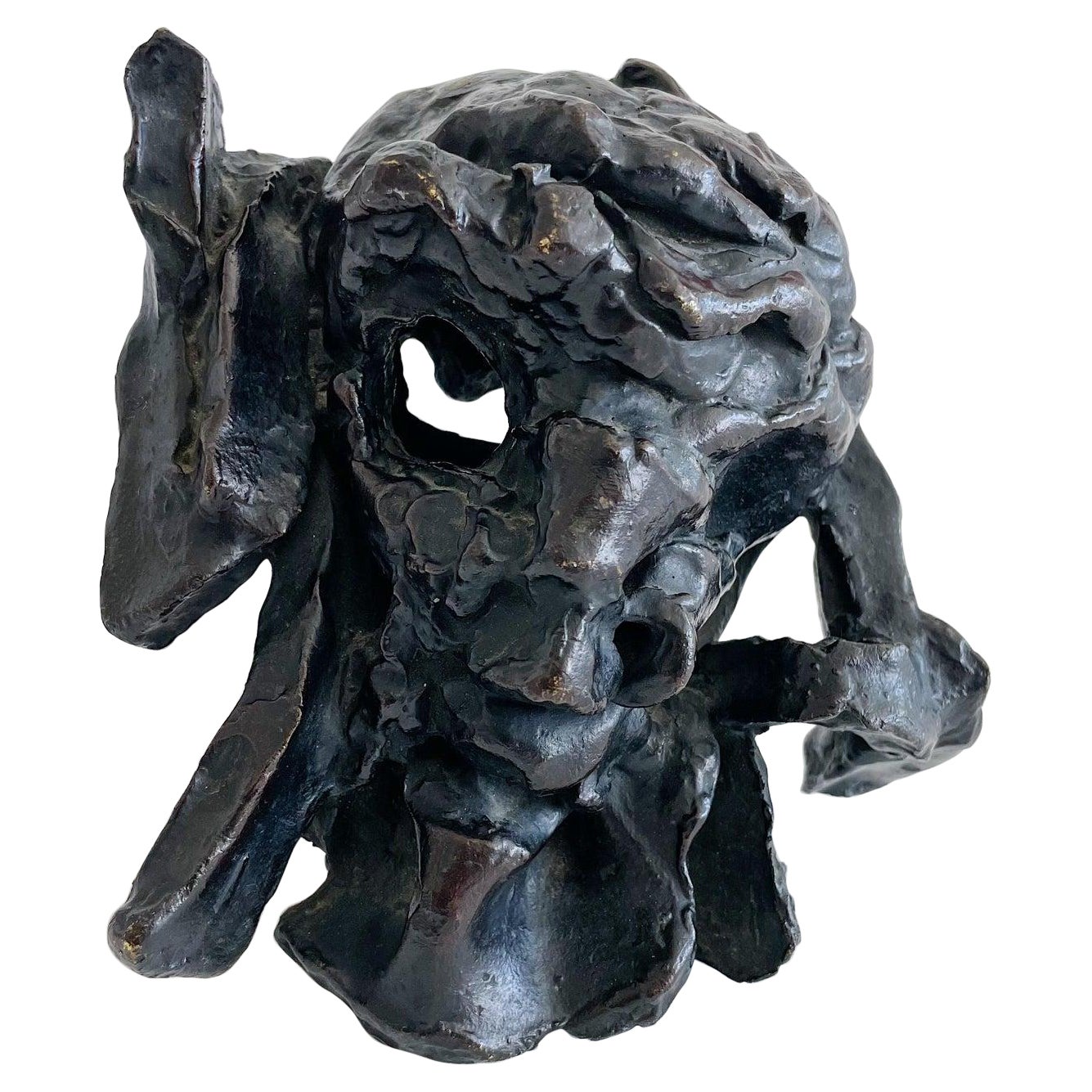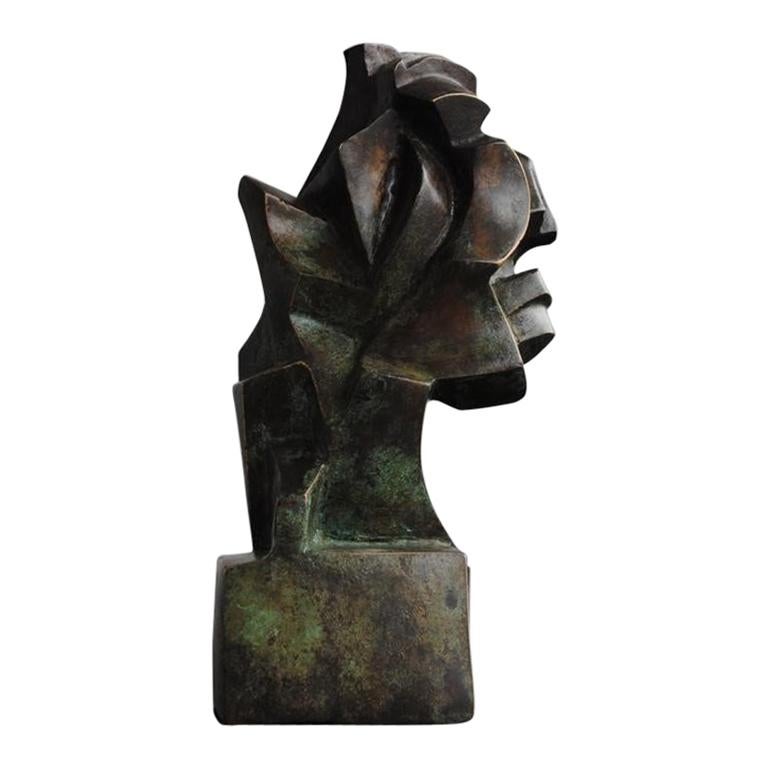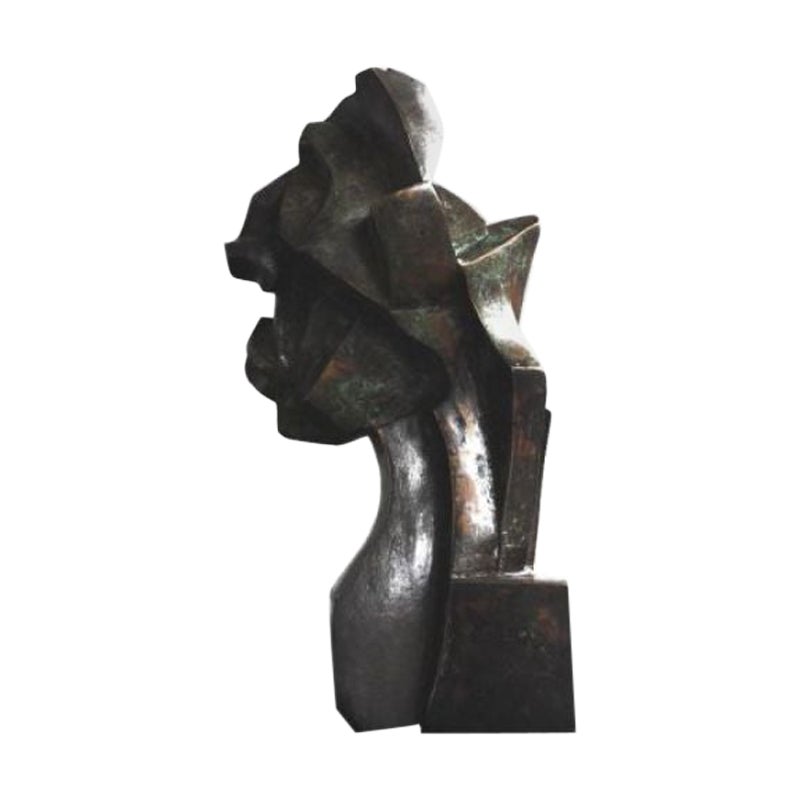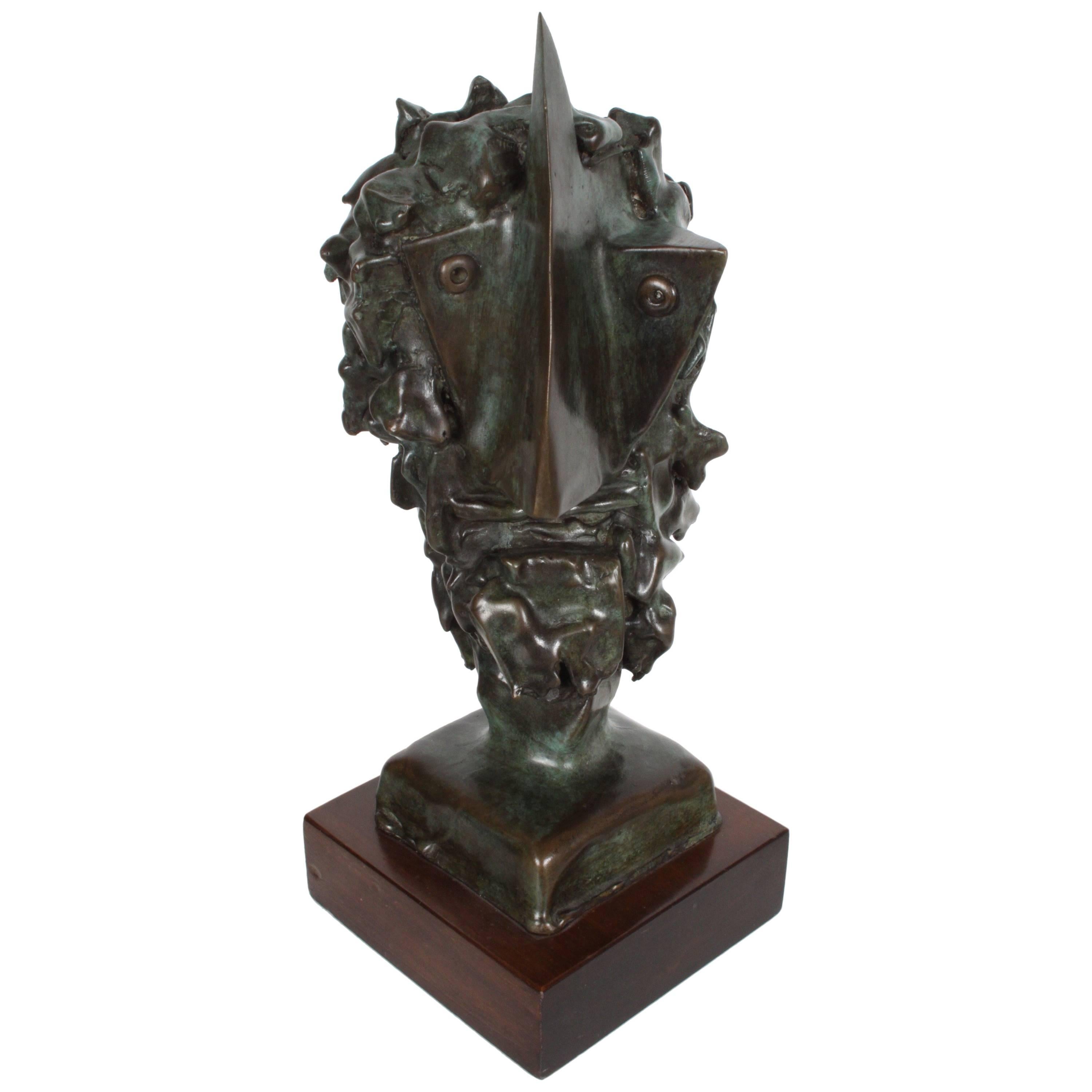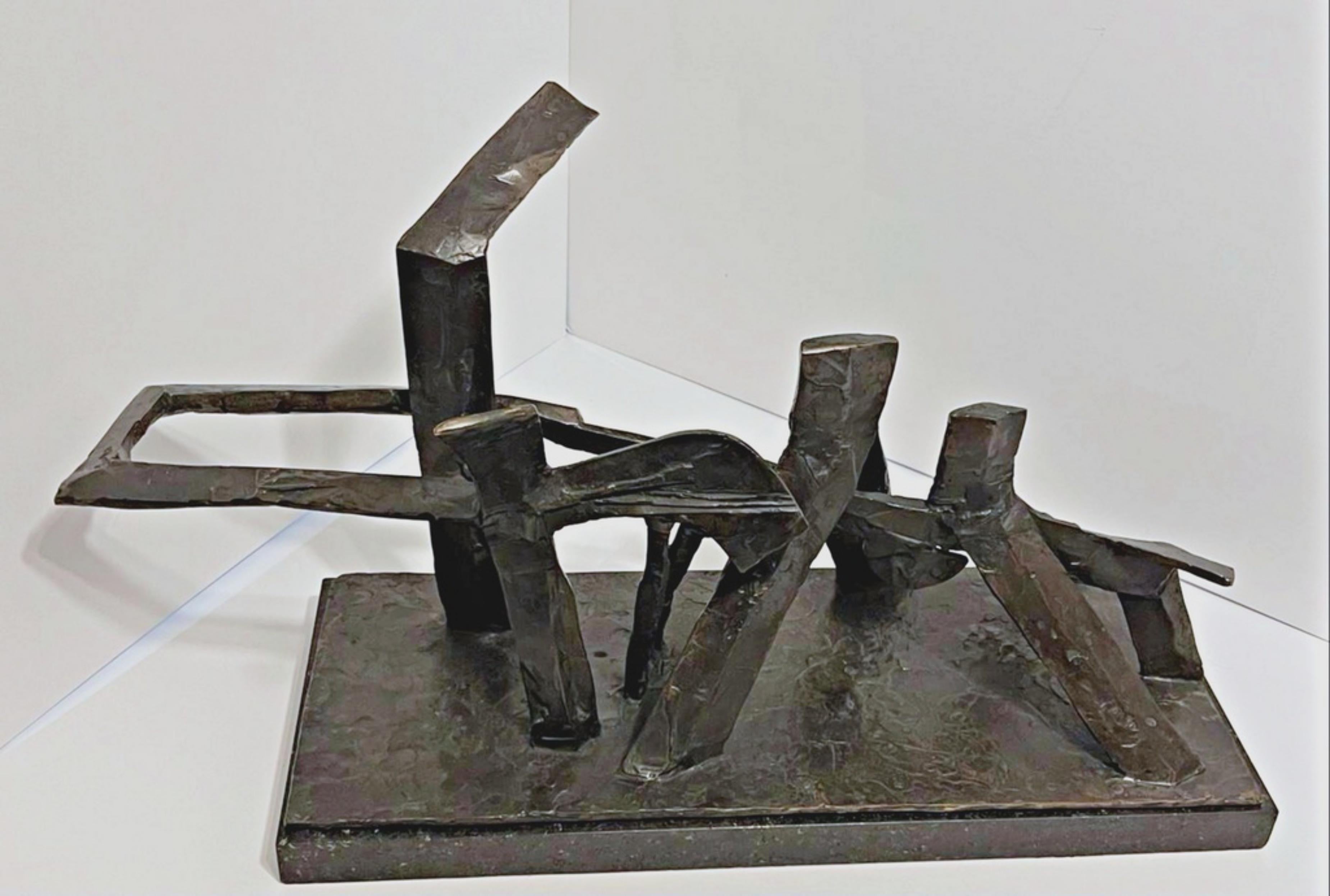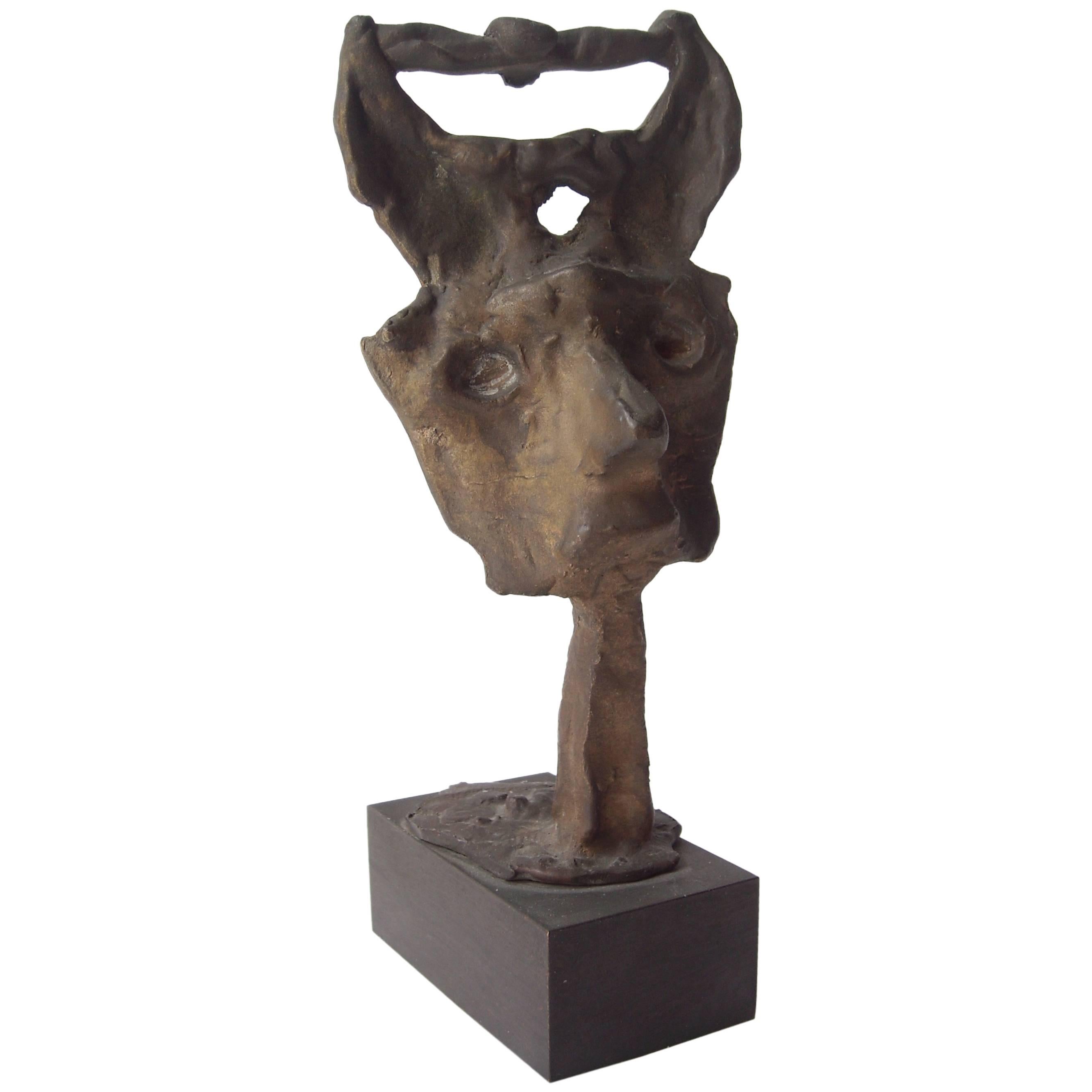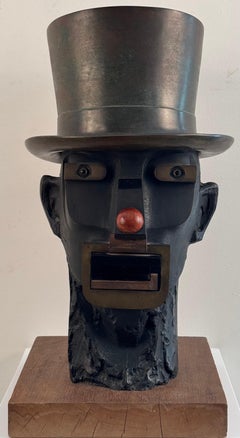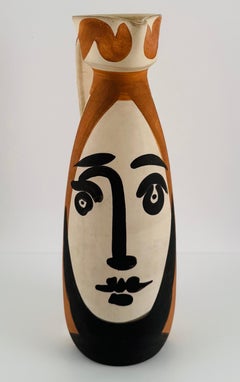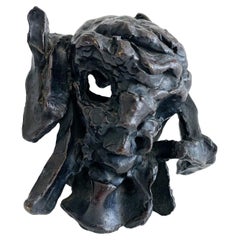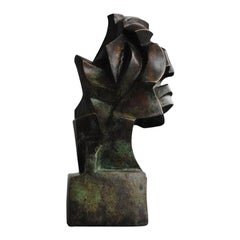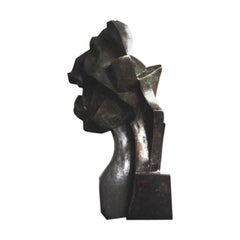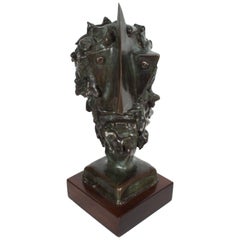Items Similar to "Petit masque découpé Montserrat", 20th Century Bronze by Julio González
Want more images or videos?
Request additional images or videos from the seller
1 of 8
Julio González"Petit masque découpé Montserrat", 20th Century Bronze by Julio GonzálezCirca 1930 - 1933
Circa 1930 - 1933
Price Upon Request
Price Upon Request
Price Upon Request
Price Upon Request
Price Upon Request
Price Upon Request
Price Upon Request
Price Upon Request
Price Upon Request
Price Upon Request
About the Item
JULIO GONZÁLEZ
Spanish, 1876 - 1942
PETIT MASQUE DÉCOUPÉ MONTSERRAT
signed "GONZALEZ"
5 of an edition of 9
Cire Perdue "C. VALSUANI" foundry seal
bronze
7-3/4 x 6-1/4 x 1-1/2 inches (19.5 x 15.8 x 4 cm.)
Mounted on wood: 11-3/4 x 7-3/4 x 1-3/8 inches (30 x 19.5 x 3.5 cm.)
NOTE:
THIS WORK IS INCLUDED IN THE CATALOG REASONED BY JULIO GONZÁLEZ, VOLUME IV, PAGE 100.
PROVENANCE
Collection Particulière, Madrid, Valsuani
Frax Foundation, Spain
EXHIBITED
Museum IVAM (Valencia´s Institute of Modern Art), Valencia, Spain
Biography
Julio González (21 September 1876 – 27 March 1942), born in Barcelona, was a Spanish sculptor and painter who developed the expressive use of iron as a medium for modern sculpture. He was from a lineage of metalsmith workers and artists. His grandfather was a goldsmith worker and his father, Concordio González, a metalsmith worker who taught him the techniques of metalsmith in his childhood years. His mother, Pilar Pellicer Fenés, came from a long line of artists.
Julio attended Circol Artist Sant Luc, a Catholic school whose model of education was based on the medieval art guilds and influenced by the Arts and Crafts movement in England.
Youth
Julio González was born in Barcelona, on September 21, 1876. He came from a line of metalsmith workers; his grandfather was a goldsmith in Galicia. González's father, Concordio González, owned a workshop and as a young boy, González learned from him the techniques of gold, silver, and iron metalwork. He and his older brother, Joan González, both studied these techniques. Further, all three González children studied at Circol Artist Sant Luc, a Catholic school that remodeled its education on the medieval art guilds, influenced by the Arts and Crafts movement in England. In 1896, González's father, died. The family workshop was passed onto the older son, Joan. With Joan directly involved with the family workshop, Joan and Julio focused on their metalwork techniques and artistic aspirations. By the end of the century, both brothers began to frequent visiting Els Quatre Gats, a café which was the meeting point of many artists, especially those related with modernisme. It was there where they met artists like Joan Miró and Pablo Picasso.
By the turn of the 20th century, Pablo Picasso and Julio González became great friends. González moved to Paris in 1902, but traveled to Barcelona several times in the early 20th century. At the Picasso Museum in Barcelona, their close friendship is verified by a drawn portrait, entitled "Julio González and the Robust Man Seen from Behind". They remained close friends until 1908; scholars do not know why their friendship ended at this time, but based on González archival materials, it appears to be related to previous dispute with Julio's brother, Joan.
Paris
In Paris he associated with the Spanish circle of artists of Montmartre, including Pablo Gargallo, Juan Gris and Max Jacob. In 1918, he developed an interest in the artistic possibilities of welding, after learning the technique whilst working in the Renault factory at Boulogne-Billancourt. This technique would subsequently become his principal contribution to sculpture, though during this period he also painted and —especially— created jewellery pieces. In 1920 he renewed his acquaintance with Picasso, for whom he later provided technical assistance in executing sculptures in iron, participating to Picasso's researches on analytic cubism. He also forged the infrastructures of Constantin Brâncuși's plasters. In the winter of 1927–28, he showed Picasso how to use oxy-fuel welding and cutting. When their friendship re-established itself, Picasso and González collaborated on a piece called Woman in the Garden between 1928–1930.[1] From October 1928 till 1932, both men worked together—and in 1932, González was the only artist with whom Picasso shared his own personal art notebook. Influenced by Picasso, the fifty-year-old González deeply changed his style, exchanging bronze for iron, and volumes for lines. González began to formalize a new visual language in sculpture that would change the course of his career.
Ironwork 1932–1937
González created ironwork at this time that would establish him as "the father of all iron sculpture of this century". During the early 1930s, few artists utilized forged or welded metal as a potential medium for their art. This is because, at the time, many artists did not directly work with the medium. Rather, artists worked with a foundry and expert technicians to execute the works of art. González was unique in this instance because his work demanded an active interaction- something that required the skills shaped by a long and specialized apprenticeship. In 1937 he contributed to the Spanish Pavilion at the World Fair in Paris (La Montserrat, standing near Guernica), and to Cubism and Abstract Art at the Museum of Modern Art in New York.
1938–1942: later years
As González aged between 1938 and 1940, he drew more. These later works, as scholar Joseph Withers states, “touch on larger problems and personal concerns which necessitated our discussion of these works in the context of González's evidently pessimistic reaction to the Spanish Civil War and the Second World War. Julio González was directly affected by the Second World War; his daughter Roberta González married German painter—and Julio's assistant—Hans Hartung in 1938. When the German invasion occurred in France, the couple had to separate from the rest of the family since Hans Hartung was an anti-Nazi and was wanted by the German secret police. While separated from his daughter and son-in-law, Julio Gonzalez drew figurative drawings and worked on plaster casts. The drawings and castings produced during the last two years of his life are testimonies to the suffering and despair Gonzalez felt towards tyranny and war. Julio Gonzalez died in Arcueil on March 27, 1942.
Public collections
The Art Institute of Chicago, the Cleveland Museum of Art, the Hirshhorn Museum and Sculpture Garden (Washington D.C.), the Honolulu Museum of Art, the Kröller-Müller Museum (Otterlo, Netherlands), the Los Angeles County Museum of Art, the Luís Ángel Arango Library (Bogotá, Colombia), the Mary and Leigh Block Museum of Art (Northwestern University, Evanston, Illinois), Musée des Beaux-Arts de Rennes (France), Museo Nacional Centro de Arte Reina Sofía (Madrid) Museo Patio Herreriano de Valladolid (Spain), Museu Nacional d'Art de Catalunya (Barcelona, Spain), the Museum of Modern Art (New York City), the Nasher Sculpture Center (Dallas, Texas), the National Gallery of Scotland (Edinburgh), the Peggy Guggenheim Collection (Venice), the Philadelphia Museum of Art, the Pompidou Center (Paris), the Solomon R. Guggenheim Museum (New York City), and the Tate Gallery (London) are among the public collections holding work by Julio González. The biggest collection of this artist's work is held by the IVAM (Valencia's Institute of Modern Art), in the city of Valencia, Spain, with close to 400 pieces.
Biography Julio González (21 September 1876 – 27 March 1942), born in Barcelona, was a Spanish sculptor and painter who developed the expressive use of iron as a medium for modern sculpture. He was from a lineage of metalsmith workers and artists. His grandfather was a goldsmith worker and his father, Concordio González, a metalsmith worker who taught him the techniques of metalsmith in his childhood years. His mother, Pilar Pellicer Fenés, came from a long line of artists.
Julio attended Circol Artist Sant Luc, a Catholic school whose model of education was based on the medieval art guilds and influenced by the Arts and Crafts movement in England. Ironwork 1932–1937 González created ironwork at this time that would establish him as "the father of all iron sculpture of this century". During the early 1930s, few artists utilized forged or welded metal as a potential medium for their art. This is because, at the time, many artists did not directly work with the medium. Rather, artists worked with a foundry and expert technicians to execute the works of art. González was unique in this instance because his work demanded an active interaction- something that required the skills shaped by a long and specialized apprenticeship. In 1937 he contributed to the Spanish Pavilion at the World Fair in Paris (La Montserrat, standing near Guernica), and to Cubism and Abstract Art at the Museum of Modern Art in New York. Public collections The Art Institute of Chicago, the Cleveland Museum of Art, the Hirshhorn Museum and Sculpture Garden (Washington D.C.), the Honolulu Museum of Art, the Kröller-Müller Museum (Otterlo, Netherlands), the Los Angeles County Museum of Art, the Luís Ángel Arango Library (Bogotá, Colombia), the Mary and Leigh Block Museum of Art (Northwestern University, Evanston, Illinois), Musée des Beaux-Arts de Rennes (France), Museo Nacional Centro de Arte Reina Sofía (Madrid) Museo Patio Herreriano de Valladolid (Spain), Museu Nacional d'Art de Catalunya (Barcelona, Spain), the Museum of Modern Art (New York City), the Nasher Sculpture Center (Dallas, Texas), the National Gallery of Scotland (Edinburgh), the Peggy Guggenheim Collection (Venice), the Philadelphia Museum of Art, the Pompidou Center (Paris), the Solomon R. Guggenheim Museum (New York City), and the Tate Gallery (London) are among the public collections holding work by Julio González. The biggest collection of this artist's work is held by the IVAM (Valencia's Institute of Modern Art), in the city of Valencia, Spain, with close to 400 pieces.
About the Seller
5.0
Vetted Professional Seller
Every seller passes strict standards for authenticity and reliability
Established in 1977
1stDibs seller since 2019
21 sales on 1stDibs
Typical response time: 2 hours
- ShippingRetrieving quote...Shipping from: Madrid, Spain
- Return Policy
Authenticity Guarantee
In the unlikely event there’s an issue with an item’s authenticity, contact us within 1 year for a full refund. DetailsMoney-Back Guarantee
If your item is not as described, is damaged in transit, or does not arrive, contact us within 7 days for a full refund. Details24-Hour Cancellation
You have a 24-hour grace period in which to reconsider your purchase, with no questions asked.Vetted Professional Sellers
Our world-class sellers must adhere to strict standards for service and quality, maintaining the integrity of our listings.Price-Match Guarantee
If you find that a seller listed the same item for a lower price elsewhere, we’ll match it.Trusted Global Delivery
Our best-in-class carrier network provides specialized shipping options worldwide, including custom delivery.More From This Seller
View AllRamoneur IV
By Eduardo Arroyo
Located in Madrid, ES
EDUARDO ARROYO
Spanish, 1937 - 2018
RAMONEUR IV
signed, dated and numbered "ARROYO / 1982 / 1/6" (on the side of the neck)
"MAGISA" foundry seal (on the side of the neck)
bronze and ...
Category
1980s Cubist Figurative Sculptures
Materials
Bronze
"A Girl Bust" 20th Century Bronze Sculpture by Spanish Artist Juan Clará Ayats
Located in Madrid, ES
JUAN CLARÁ AYATS
Spanish, 1878 - 1958
A GIRL BUST
signed "Juan Clara" and Buenos Aires stamp mark (on the back )
bronze figure
6-3/8 x 4-1/8 x 4-1/8 inches (16 x 10.5 x 10.5 cm.)
8 x 4-1/8 x 4-1/8 inches (20 x 10.5 x 10.5 cm.) base included
PROVENANCE
Private Spanish Collector
Art Noveau bronze...
Category
1920s Art Nouveau Figurative Sculptures
Materials
Bronze
"Art Nouveau Sculptural Bronze Group of Children", 20th Century by Juan Clará
Located in Madrid, ES
JUAN CLARÁ AYATS
Spanish, 1878 - 1958
ART NOUVEAU BRONZE GROUP OF CHILDREN
signed "Juan Clara" (lower right on the bench)
bronze sculpter group
4-3/4 x 6 x 3-1/2 inches (12 X 15 X 9 cm.)
PROVENANCE
Private Spanish Collector
Juan Clará's Art Nouveau bronze sculptural group representing two boys and a girl sitting on a bench in a funny and surprise attitude to something they are seeing.
Juan Clará's Art Nouveau bronze sculptural group representing two boys and a girl sitting on a bench in a funny and surprise attitude to something they are seeing.
Juan Clará Ayats. Olot (Gerona), 6.XII.1875 - Paris (France), II.1958. Sculptor
Student of José Berga at the Olot School of Fine Arts, developed his training in France, first at the School of Fine Arts in Toulouse, in 1896, and from 1901 in Paris. At this stage he lived with his younger brother, José Clará...
Category
1920s Art Nouveau Figurative Sculptures
Materials
Bronze
Pablo Picasso, Visage (A.R. 288)
By Pablo Picasso
Located in Madrid, ES
PABLO PICASSO (1881-1973)
Visage (A.R. 288)
stamped and marked 'Edition Picasso / Madoura Plein Feu / Edition Picasso / Madoura' (underneath)
white earthenware ceramic pitcher with c...
Category
1950s Modern Sculptures
Materials
Ceramic
Visage de Femme (A.R. 192). Ceramic Stamped Madoura Plein Feu, Edition Picasso
By Pablo Picasso
Located in Madrid, ES
PABLO PICASSO
Spanish, 1881-1973
VISAGE DE FEMME (A.R. 192)
stamped, marked and numbered 'Edition Picasso / Madoura Plein Feu / Edition Picasso / 154/200 / Madoura' (underneath)
whi...
Category
1950s Modern More Art
Materials
Ceramic
"Art Nouveau Bronze Sculptural of a Boy and Girl", 20th Century by Juan Clará
Located in Madrid, ES
JUAN CLARÁ AYATS
Spanish, 1878 - 1958
ART NOUVEAU SCULPTURAL BRONZE OF A BOY AND GIRL
signed "Juan Clara" (on the lower left )
sculptural bronze
4-3/8 x 4-3/8 x 3-1/2 inches (11 X 11 X 9 cm.)
PROVENANCE
Private Spanish Collector
Art Nouveau Bronze sculpture representing a boy and a girl sitting on a stool in a funny and surprised attitude to something they are seeing. Sgned "Juan Clará" lower left with the foundry seal and marks on the right side of the bench
Juan Clará Ayats. Olot (Gerona), 6.XII.1875 - Paris (France), II.1958. Sculptor
Student of José Berga at the Olot School of Fine Arts, developed his training in France, first at the School of Fine Arts in Toulouse, in 1896, and from 1901 in Paris. At this stage he lived with his younger brother, José Clará...
Category
1920s Art Nouveau Figurative Sculptures
Materials
Bronze
You May Also Like
Mid Century Abstract Face Bronze Sculpture by Jean Robert Ipousteguy
By Jean-Robert Ipoustéguy
Located in West Palm Beach, FL
Bronze abstract face sculpture by Jean-Robert Ipoustéguy (January 6, 1920 – February 8, 2006, a figurative French sculptor.. Signed on back underside Ipoustegy '66 2/9.
I'm many museum and public art collections such as:
Abu Dhabi, National Museum of Saadiyat Island.
Baltimore, Baltimore Museum of Art.
Berlin, Nationalgalerie.
Bobigny, Fonds Départemental d’Art Contemporain.
Cambridge, Massachusetts, US (Massachusetts Institute of Technology, MIT) — Cénotaphe (1957)[8]
Châlons en Champagne, Musée des Beaux-Arts et d'Archéologie.
Chicago, Art Institute.
Copenhagen, Carlsberg Glyptotek.
Darmstadt, Hessiches Landesmuseum.
Dun sur Meuse, Centre Ipoustéguy
Evanston, Illinois, Mary and Leigh...
Category
Vintage 1960s French Mid-Century Modern Abstract Sculptures
Materials
Bronze
Contemporary Cubist Head in Bronze by Perrine Le Bars
By Perrine Le Bars
Located in Marseille, FR
Cubist bronze sculpture by Perrine Le Bars. Cast by "Fa Boniface Bassan côte d'ivoire".
Category
20th Century French Abstract Sculptures
Materials
Bronze
Contemporary Bronze Cubist Head
By Perrine Le Bars
Located in Marseille, FR
Cubist head in bronze by Perrine Le bars 2014 founder Fa Boniface Bassan Ivory Coast EA IV/IV Dimension height 20 cm for a width of 11 cm and a depth of 8 ...
Category
Vintage 1980s Abstract Sculptures
Materials
Bronze
Jean Mahie Bronze Cubist Head Sculpture Titled Veneration
By Jean Mahie
Located in St. Louis, MO
Artist and jewelry designer Jean Mahie signed and numbered bronze head titled" Veneration", circa 1987 from her collection I series of sculptures. Signed and numbered 3/8. An example...
Category
Vintage 1980s French Abstract Sculptures
Materials
Bronze
Uxmal, unique bronze sculpture by Greek-American sculptor and Harvard professor
Located in New York, NY
Dimitri Hadzi
Uxmal, 1991
Cast bronze on custom made granite base
17 × 30 1/2 × 14 inches
The title UXMAL, refers to the ancient Mayan city of Uxmal, which is known for its "Pyramid of the Magician"
Provenance:
Acquired by the original owner from the prestigious Gremillion Gallery in Houston, Texas (accompanied by a copy of the original receipt)
Measurements:
Base:
26.5 by 11 by 1.75 inches
Work longest
30.5 inches
Widest 14 inches
Highest. 17 inches
More about Dimitri Hadzi"
Derived from the figure and mythic narratives, Hadzi’s sculpture references antiquity and classical artifacts – abstracted anatomical forms, columnar and other architectural elements, helmets, weaponry and body armor function as visual metaphors for ancient cultures. “I was interested in mythology, and I was interested in movement,” Hadzi remarked on his years in Rome, “I was attempting through formal methods to exaggerate sexual tension or apprehension. Suddenly I was myself in an atmosphere of freedom.” [1] Powerfully rendered in bronze his sculptures convey raw emotion, brute strength and mass, tempered with a delicate rush of whimsy, vivacity and sensuality.
Born in New York City on March 21, 1921, Hadzi graduated from Cooper Union in 1950 and received a Fulbright Fellowship in the same year. After studying sculpture in Greece, he moved to Rome under the GI Bill where he lived for twenty-five years. Hadzi returned to the U.S. where he taught at Harvard University for fourteen years. He continued to create sculpture until his death in 2006.
Hadzi is included in the permanent collections of the Museum of Modern Art; the Whitney Museum of American Art; the Museum of Fine Arts, Boston; the Hirshhorn Museum and Sculpture Garden; The Phillips Collection and the Guggenheim Museum. Receiving over twenty sculpture commissions, Hadzi’s work appears in public squares, concert halls, federal and private plazas, and universities throughout the world.
---------------
[1] Elsen, Albert. “On Artistic Freedom: An Interview,” Dimitri Hadzi, (New York: Hudson Hills Press, 1996), 30.
Additional Biography:
Dimitri Hadzi (1921 – 2006) is among the most distinguished modernist sculptors, creator of works in bronze and stone that are powerfully abstract and expressionist in character. His contribution to the international language of sculpture continues to influence and inspire through permanent installations and collections, and exhibitions worldwide.
Born to Greek-American immigrant parents in New York City, he had a talent for drawing at an early age and won a prize for his young ability. But, it wasn't until after serving in the Air-force in the South Pacific during WWII that he turned his sights fully to painting and sculpture, going on to study both at Cooper Union. Eventually, he would become a mainstay of the Cambridge, MA art community. He was a Guggenheim Fellow (1957), the winner of the Venice Biennale Award (1962), and the Rome Prize (1974).
His most notable sculptures are: Copley Place Waterfall (Boston, MA), Owen Glass Co. (Toledo, OH), as well as Thermopolis, adjacent to Boston’s City Hall Plaza, and the former Omphalos in Harvard Square (Cambridge, MA).
Hadzi is included in the permanent collections of the Museum of Modern Art; National Gallery of Art; Whitney Museum of American Art; Museum of Fine Art, Boston; Hirshhorn Museum and Sculpture Garden; The Phillips Collection and the Guggenheim Museum.
Additionally, Hadzi was also a prolific painter, and printmaker. He also taught at Harvard University for over a decade. Famously, David Hockney attended one of Hadzi’s classes at the Carpenter Center at Harvard, where Hadzi served as director. The two of them spent time together painting and discussing techniques. Hockney gifted Hadzi one of his paintings.
He worked alongside his good friend, Nobel Prize winning Irish poet...
Category
1990s Abstract Abstract Sculptures
Materials
Granite, Bronze
Emerson Woelffer Bonze Sculpture, Abstract Face, Signed, Dated, Numbered
By Emerson Woelffer
Located in Los Angeles, CA
Nice modern abstract Face, by the well known artist, Emerson Woelffer. Signed, numbered 1/4 and dated 1947.
Category
Vintage 1940s American Modern Abstract Sculptures
Materials
Bronze
More Ways To Browse
Pablo Gargallo
Exile On Main Street
George Bishop
George Kilburne Goodwin
Golf Course Prints
Gordon Gilkey
Graham Smith
Greece Vintage Travel Poster
Greek Male Figure
Grey Horse Oil Paintings
Gumps Paintings
Harley Vintage Sign
Harpers Poster
Henri Matisse Goldfish
Henri Royer
Henry Watson
Hip Hop Painting
Hunt Slonem 2 Bunny Art
